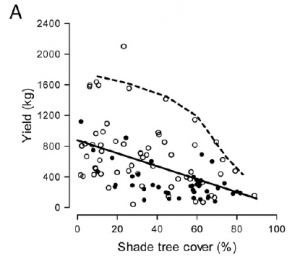Planning is well underway for my departure to Hanoi next week. I anticipate the change of scenery and new faces will help kick off the next phase of my research project which is a three-month placement in the Vietnam CIAT office.
My literature review research this last week has been focused on understanding what the various cocoa production systems are and why they’re used. Cocoa trees have historically been grown by smallholders within native tropical forests and as such they have a reputation as being a ‘shade-loving’ tree. Every cocoa production system offers different levels of shade to the cocoa trees. The choice of system may be constrained by a number of physical, economic or cultural factors such as climate or yield requirements.
I found that there are many different types of production systems ranging from highly diverse shaded agroforests (native forests and/or planted varieties) at one end of the spectrum through to full-sun monocultures. From the sources I have reviewed so far it seemed that the systems could be broadly categorised by the level of shade that they offer into the following systems:
- Diverse agroforestry systems (including both native and planted forest)
- Agroforestry systems (largely planted forests)
- Full sun cocoa with limited shade or intercropping
- Agroforestry systems on degraded land (for restoration)
My initial thoughts on other ways that the production systems could be categorised include by land type (i.e. degraded land, fallow land, native forest) or by intensity (density of cocoa trees per hectare) but all these appear to be linked in with shade to varying extents.
In Indonesia, my initial research has found that much of the cocoa production is on hillsides within districts in Sulawesi and Sumatra. Often plantations are established on degraded land (formerly used for food crops). It appears that full sun cocoa has become the most widely used system since it tends to offer higher yields in the short term and there are often land scarcity issues making intensive full sun cocoa systems more attractive than agroforestry systems. For example, a study by Clough et al. in 2011 using data from smallholder cocoa farms in Indonesia found that expected yield decreased linearly with increasing shade (see graph below).

Full sun cocoa may produce higher yields in the short term, however in the long term it has been found that full sun cocoa systems tend to experience issues relating to loss of soil fertility, biodiversity and ecosystems. and also shortening of the productive life of the tree. Additionally, some degree of shade is needed in the early and late stages of the cocoa tree’s life in order to maximise growth and productive life.
I look forward to the coming week and learning more about the advantages and disadvantages of each of the production systems and their relationship to carbon stocks on-farm. The next blog post could be from Hanoi!
